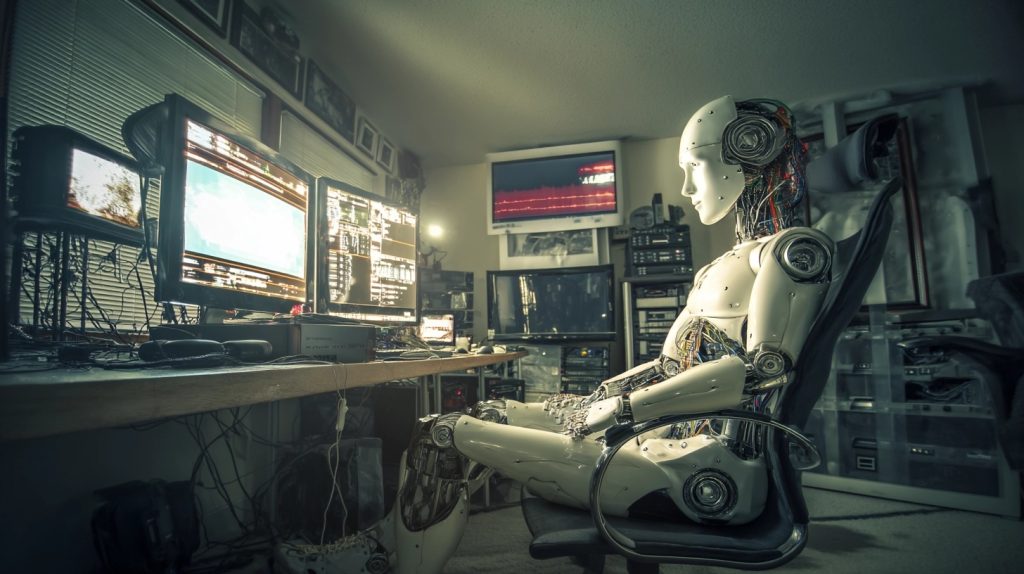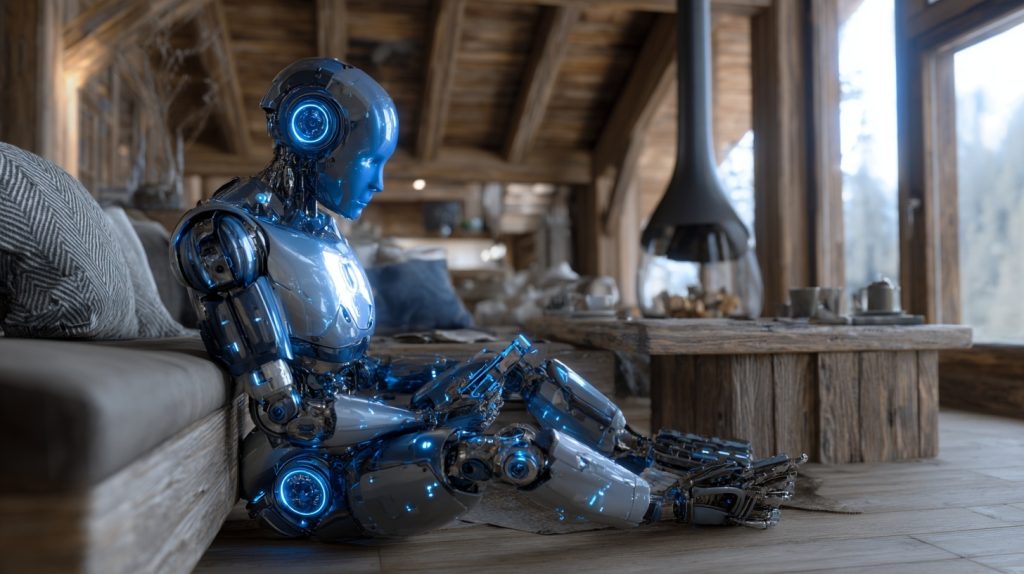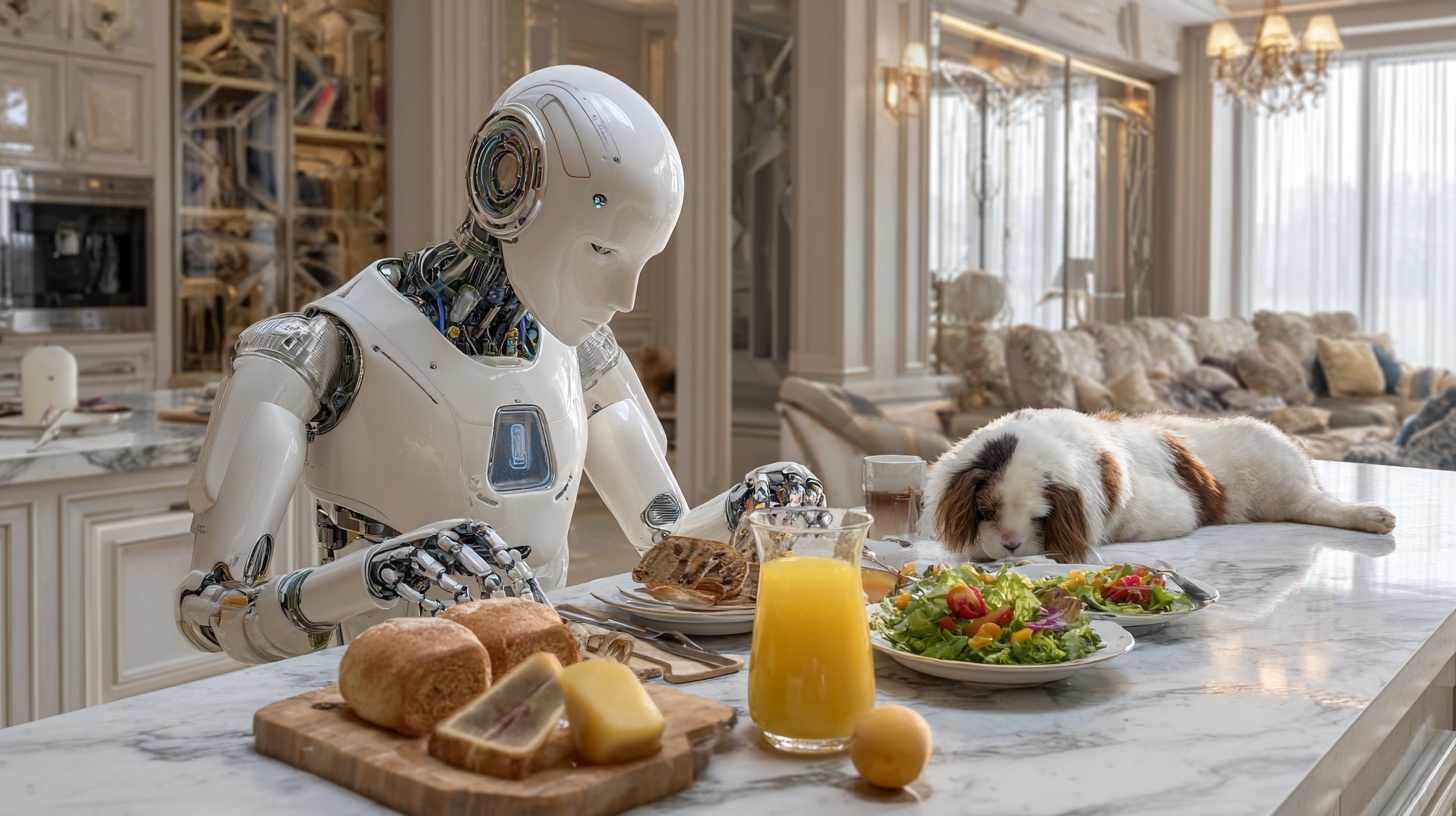By Futurist Thomas Frey
When Boston Dynamics’ Atlas does backflips or Tesla unveils its latest Optimus prototype, we imagine a future where humanoid robots seamlessly handle every household task—cooking gourmet meals, organizing closets with Martha Stewart precision, and somehow folding fitted sheets correctly. But that’s not how technology adoption works, and it’s certainly not how the robotics revolution will unfold in our homes.
The first humanoid robots we invite into our living spaces won’t be good at everything. They’ll be awkward, limited, and occasionally frustrating. They’ll drop things, misjudge distances, and require patient re-teaching. And that’s okay—because if we’re strategic about which tasks we delegate first, these early homebots could still transform daily life in profound ways.
The question isn’t whether robots will eventually master every household chore. The question is: what will be their gateway tasks? Which jobs will we trust them with first, and why?
The 70% Solution
Here’s a principle that will define early robot adoption: people will accept 70% quality if it saves them 100% of the effort on tasks they hate. A robot that folds towels with hospital corners? Unnecessary. A robot that folds towels into vaguely rectangular shapes while you’re at work? Revolutionary.
This “good enough” threshold is critical because perfectionism is the enemy of progress. We’ve already seen this with robotic vacuum cleaners—Roombas don’t clean as thoroughly as humans, they occasionally get stuck under furniture, and they require maintenance. Yet millions of households consider them indispensable because they handle the tedious baseline of floor cleaning without human intervention.
The first humanoid homebots will follow the same pattern, but with a crucial difference: they’ll have hands, height, and the ability to manipulate objects in three-dimensional space. That opens up an entirely new category of tasks that are currently beyond the reach of our rolling disc-shaped helpers.
The Prime Candidates: What Robots Will Do First
Based on current technological capabilities, market demand, and the psychology of trust-building, here are the tasks most likely to define the first generation of home robotics:
1. Laundry Management: The Gateway Task
If I had to bet on the single task that will bring humanoid robots into millions of homes, it’s laundry. Not washing or drying—machines already do that—but the soul-crushing work of transferring wet clothes, folding clean items, and putting them away.
Laundry is the perfect starter task for robots. It’s repetitive, time-consuming, and universally disliked. It requires basic object recognition and manipulation but doesn’t demand perfection. If a robot folds your jeans with a crooked seam, you won’t care. If it mismatches your socks, you’ll survive. The stakes are low, the time savings are significant, and the frustration factor is high enough that people will pay for a solution.
Moreover, laundry is predictable. Clothes come in standard shapes and fabrics. The environment—a laundry room—is controlled and consistent. There are no surprise variables, no safety risks, and no emotional attachment to the outcome. It’s an ideal training ground for both the robots and their human owners.
Expect to see the first “LaundryBot” marketed not as a general-purpose humanoid but as a specialized appliance with humanoid features—arms, vision, and enough intelligence to distinguish between a towel and a t-shirt. It won’t do everything, but it will do this one thing well enough to justify its presence in your home.
2. Physical Retrieval and Transport
The second wave of tasks will center on something humans do dozens of times per day without thinking: moving objects from one place to another. Bringing in packages from the porch. Carrying groceries from the car to the kitchen. Retrieving items from the basement. Taking the trash to the curb.
These tasks share common characteristics: they’re physically demanding, repetitive, and don’t require fine judgment. A robot that can navigate your home, identify marked objects, and transport them reliably would immediately prove its value.
Consider the elderly population. The fastest-growing demographic in developed nations struggles not with cognitive tasks but with physical mobility. A robot that can fetch medications, bring a phone within reach, or retrieve a fallen cane isn’t just convenient—it’s life-changing. It’s the difference between independence and assisted living.
This is where the market will drive rapid adoption. Adult children worried about aging parents will be early purchasers, willing to accept imperfect technology if it means their parents can safely remain in their homes longer. The robot doesn’t need to be conversational, empathetic, or particularly intelligent—it just needs to reliably bring Dad his reading glasses when he asks.
3. Floor-Level Organization
Robot vacuum cleaners taught us to accept autonomous machines moving around our homes. The next evolution is robots that don’t just avoid obstacles but actively manage them. Picking up toys scattered across the playroom. Organizing shoes by the door. Retrieving items that have rolled under furniture.
Parents of young children will be the early adopters here. The Sisyphean task of maintaining order in a house with kids is exhausting, and a robot that could handle just the floor-level chaos would be worth its weight in gold. It doesn’t need to organize the toys beautifully—it just needs to get them off the floor and into designated bins before someone steps on a LEGO brick.
This task requires more sophisticated vision and decision-making than pure transport tasks. The robot needs to distinguish between trash and treasures, between items that belong in a toy box and items that belong in the kitchen. But the consequences of mistakes are minimal. If the robot puts a action figure in the wrong bin, a child will find it eventually. There’s room for error, and that room is where early-stage AI will live.
4. Pet Care Assistance
Pet owners are already comfortable delegating animal care to automated systems—timed feeders, automatic water fountains, robotic litter boxes. A humanoid robot that can refill food bowls, provide fresh water, throw tennis balls, and monitor pet behavior is a natural extension of this trend.
The task complexity is moderate. Pets are unpredictable, but their needs are routine. A robot doesn’t need to understand why the dog is barking, only that it needs to check the water bowl or alert a human if the barking continues. It doesn’t need to bond with the cat, only ensure the litter box is maintained.
For working professionals who feel guilty about leaving pets alone all day, a robot companion—even a rudimentary one—offers peace of mind. It’s not a replacement for human interaction, but it’s a significant upgrade from an empty house.
5. Kitchen Prep (Not Cooking)
Full robotic cooking is years away—too many variables, too much safety risk, too much aesthetic judgment required. But kitchen prep work? That’s approachable. Unloading groceries from bags onto counters. Emptying the dishwasher and placing items in approximate locations. Wiping down countertops. Taking out the trash.
These are the tasks that bookend actual cooking—necessary but tedious. A robot that could handle the setup and cleanup while humans focus on the creative aspects of cooking would find a ready market among home cooks who love preparing food but hate the surrounding drudgery.
The key is setting appropriate expectations. Early models won’t put dishes away in precisely the right cabinets. They’ll place items in designated zones, and humans can fine-tune from there. They won’t hand-wash delicate glassware. They’ll handle the routine, the repetitive, the boring—and that’s enough.

What We Won’t See (Yet)
It’s equally important to understand what tasks will remain firmly in human hands during the first generation of home robotics:
Childcare is off-limits, both technologically and psychologically. No parent is ready to delegate supervision of their children to a machine that might misinterpret a situation or fail at a critical moment. The liability alone makes this a non-starter.
Detailed cleaning requires aesthetic judgment that current AI cannot replicate. Dusting around collectibles, organizing bookshelves, arranging decorative items—these tasks demand an understanding of human preferences and cultural context that’s beyond near-term capabilities.
Cooking involves real-time problem-solving, safety management, and creative judgment. A robot that can follow a recipe perfectly still can’t taste, adjust seasoning, or recognize when something is burning. The gap between food prep and food preparation is enormous.
Anything requiring trust with valuables—handling heirlooms, organizing important documents, managing jewelry—will remain human territory until robots have proven themselves with lower-stakes tasks first.
The Psychology of Adoption
The success of early homebots will depend less on technological capability and more on psychological acceptance. We need to build trust gradually, starting with tasks where failure is annoying but not catastrophic.
This is why laundry and retrieval tasks are so strategic. When a robot mis-folds a towel, you re-fold it. When a robot brings you the wrong book, you correct it. These are low-stakes errors that allow humans and robots to calibrate their working relationship without serious consequences.
Compare that to a robot preparing food (potential poisoning), watching children (potential injury), or handling financial documents (potential loss). The emotional and practical stakes are too high for experimental technology. We need proof of reliability before we expand the scope of delegation.
There’s also the question of anthropomorphization. Humans naturally attribute human-like qualities to humanoid forms. A robot with arms, legs, and a “face” will trigger social instincts that a Roomba never could. Early adopters will name their robots, apologize when giving them difficult tasks, and feel genuine frustration when they fail.
Manufacturers will need to manage these expectations carefully. Marketing that oversells capabilities will lead to disappointment and returned products. The companies that succeed will be those that honestly position their robots as limited, learning systems that improve over time—more like puppies than employees.
The Economic Equation
For homebots to achieve mass adoption, the economics need to make sense. A robot that costs $20,000 and saves five hours per week needs to operate reliably for years to justify the investment. Early adopters—wealthy households, dual-income families, elderly individuals seeking independence—will subsidize the technology development, but mainstream success requires either dramatic price reductions or dramatic capability increases.
The winning formula might be subscription models. Rather than buying a robot outright, households could lease robots that are regularly updated, repaired, and eventually replaced by newer models. This shifts the risk from consumers to manufacturers while ensuring a steady revenue stream for ongoing AI improvements.
We’re also likely to see task-specific robots before true general-purpose models. A $3,000 LaundryBot that does one thing brilliantly is more compelling than a $20,000 general-purpose robot that does everything poorly. Specialization allows for targeted marketing, clearer value propositions, and faster iteration on specific capabilities.

The Road Ahead
The first generation of home robots will be judged not by what they can do, but by what they free us to do. A robot that handles laundry doesn’t just save time—it eliminates a source of weekend stress, allowing families to spend those hours together instead. A robot that helps an elderly person retrieve dropped items doesn’t just solve a physical problem—it preserves dignity and independence.
This is the value proposition that will drive adoption: not robotic perfection, but human liberation from the tedious baseline of household maintenance. The tasks nobody enjoys, nobody wants to do, and everybody wishes would somehow handle themselves.
We’re not far from this reality. The technology exists. The market demand is clear. What remains is the engineering challenge of making these systems reliable enough and affordable enough for widespread deployment.
Final Thoughts
When historians look back at the robotics revolution, they won’t remember the first robot that could do everything. They’ll remember the first robot that could do one thing well enough that millions of people invited it into their homes.
My prediction? That task will be laundry. Mundane, universal, and perfectly suited for the capabilities of early-stage humanoid robots. From there, we’ll gradually expand the scope—retrieval, organization, pet care, kitchen prep. Each successful task will build trust for the next, until one day we look around and realize that robots have become as common in our homes as dishwashers and microwaves.
The future of home robotics won’t arrive as a sudden revolution. It will creep in through laundry rooms and entryways, proving its value one tedious task at a time. And we’ll wonder how we ever lived without it.
Related Links:
The Evolution of Household Robotics Technology
Consumer Attitudes Toward Domestic Robots


